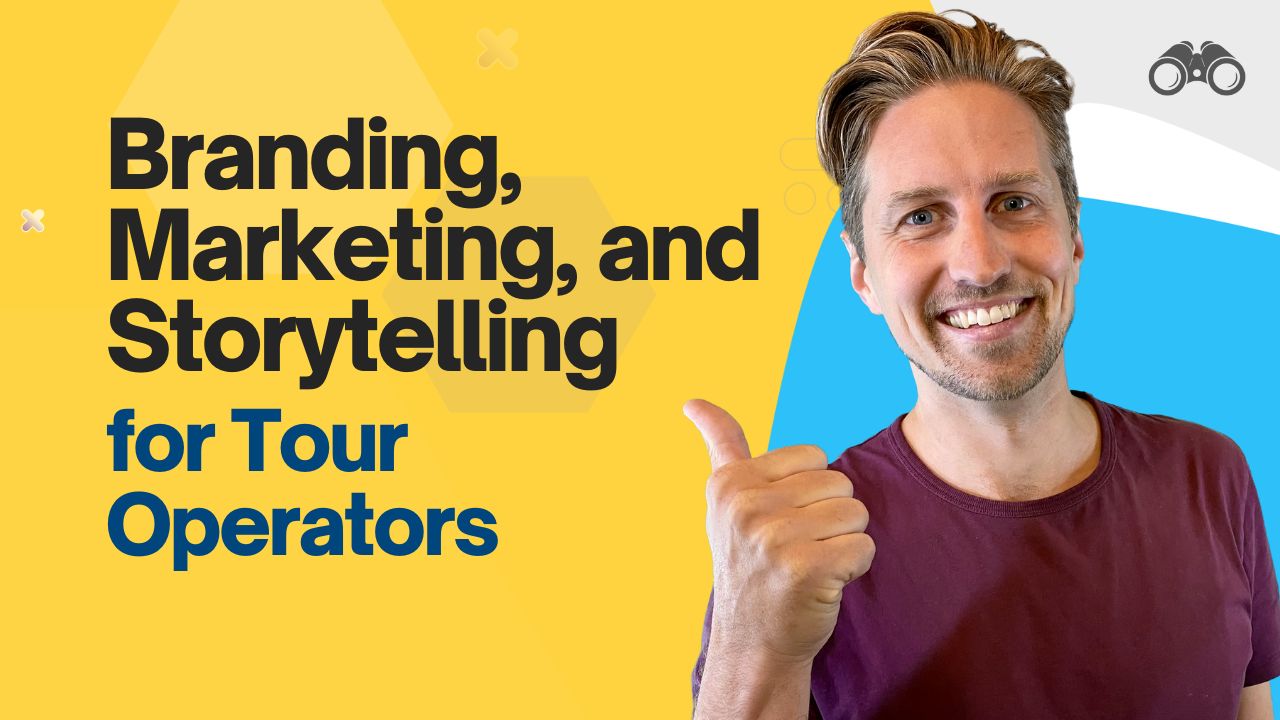Branding, Marketing, and Storytelling for Tour Operators
This is the third video in our VIP Marketing Method™ series. Be sure to tune into video 1 and video 2!
“Your brand is what other people say about you when you’re not in the room.” – Jeff Bezos
For tour operators, this couldn’t be more true. Your brand speaks volumes before your guests ever set foot on a tour or on your website. But here’s the kicker: most tour operators are leaving too much to chance by neglecting their branding. Let’s change that.
That means taking a guest-focused look at branding, marketing, and storytelling for tour operators. This week, we’ll explore the often-misunderstood difference between branding and marketing, walk you through creating effective brand guidelines, and introduce you to the StoryBrand framework—a powerful tool that complements our Guest Focus formula and VIP Marketing Method™.
Branding vs. Marketing: Not Quite Siblings, More Like Cousins
If you’ve ever found yourself scratching your head over the terms “branding” and “marketing,” know that you’re not alone in feeling confused. Sometimes, conversations about branding seem to swallow up all of marketing. Let’s clear the air.
Think of branding as the foundation of your tour business’s identity. It’s who you are at your core. Marketing, on the other hand, is how you shout about that identity from the rooftops.
Branding: Your Business’s DNA
Branding includes:
- Your logo and visual identity (the face you show the world)
- Your brand voice and messaging (how you talk to your guests)
- Your values and mission (what you stand for)
- The consistent experience customers have with your brand, business, and team at every touchpoint (how you make people feel)
Branding is about establishing who you are as a business. It’s how you differentiate from competitors and create a consistent connection with your ideal target guest. Consistency here is key—it’s the glue that holds everything together.
Marketing: Your Business’s Megaphone
Marketing is all about actively promoting your business and brand. It’s how you capture attention and attract those ideal target guests to your offers.
Marketing strategies include:
- Content marketing(blogs, videos, podcasts)
- Social media posting and engagement
- Paid digital advertising
- Email campaigns
- PR and media coverage
- SEO and SEM (search engine optimization and search engine marketing)
Here’s the crucial part: effective marketing needs to align with your brand values and identity. If your marketing campaigns have different logos, color schemes, tones, or messaging, you’re likely to confuse potential customers. Trust and rapport come from consistency across all your marketing efforts.
Creating Brand Guidelines: Your Business’s Blueprint
Now that we’ve established branding comes before marketing, what does this mean in practice? You need to create brand guidelines or a brand kit. This is a living document that evolves over time, essential not just for you and your team, but also for any external partners helping with your marketing.
Here are five core areas to include in your brand guidelines:
1. Your Logo: Start with a professional designer or use platforms like 99designs or Canva. Your logo should be simple, memorable, and reflective of your brand’s personality. Create variations: full color, black, white, and an icon version. Use PNG files for transparent backgrounds and vector files for scalability.
2. Color Palette: Choose 2-3 primary colors and 2-3 complementary secondary colors. Make sure they work well together and reflect your brand’s personality. Document the exact color codes using hex or RGB for consistency.
3. Typography: Select one or two fonts for headers and body text. They should be legible, clear, and work well together. Consider licensing requirements if you’re using premium fonts.
4. Brand Voice: Describe your brand’s personality. Are you friendly? Professional? Adventurous? Create guidelines for tone and language use, including words or phrases to use or avoid in your copywriting.
5. Key Messages: Write your brand and business tagline, 3-5 key messages that encapsulate your brand’s value proposition and offer, and create an elevator pitch describing your business, who you serve, and how you do it.
The StoryBrand Framework: Putting Your Customer in the Spotlight
Now, let’s talk about your brand messaging. This is where many tour operators stumble. They don’t know how to succinctly explain what they do in a way that’s both clear and compelling.
While there are many approaches to branding, one of our favorites is the StoryBrand framework from Donald Miller. It’s based on a simple but powerful idea: good businesses know that telling a great story can make their brand more memorable.
The most important insight from this framework? Your company is not the hero of the story. Your customer is. Your brand and company play the role of a mentor, there to help your customer achieve their goals or overcome obstacles.
The Seven Elements of the StoryBrand Framework
1. A character (your ideal target guest)
2 Has a problem
3. Meets a guide (your business)
4. Who gives them a plan
5. And calls them to action
6. That helps them avoid failure
7. And ends in success
Let’s see this in action with a real-world example: Islamic Travel, a multi-day tour operator based in Australia.
1. Character: Australian Muslims looking for organized group travel experiences
2. Problem: Difficulty finding travel options that align with Islamic values and needs
3. Guide: Islamic Travel positions themselves as experts for Muslim travelers
4. Plan: Choose from curated Muslim-friendly destinations with all details handled
5. Call to Action: “Book your next adventure” or “Download a Muslim-friendly travel guide”
6. Avoid Failure: Missing out on enriching travel experiences
7. End in Success: Embracing Islamic heritage while exploring the world
Wrapping Up: Your Brand, Your Story
Your branding is your business’s identity. It’s how you show up in the world and communicate with others. Marketing is the set of strategies you use to amplify that identity and get the word out.
Here’s what to do next:
1. Create or update your brand guideline document or brand kit
2. Apply the StoryBrand framework to your own business and ideal target guests
3. Add this to your brand guidelines
Remember, establishing your ideal target guest as the hero of your brand story is the key to effective brand messaging. It’s not about having all the answers or promising the moon—it’s about showing your guests how you can help them on their journey.




